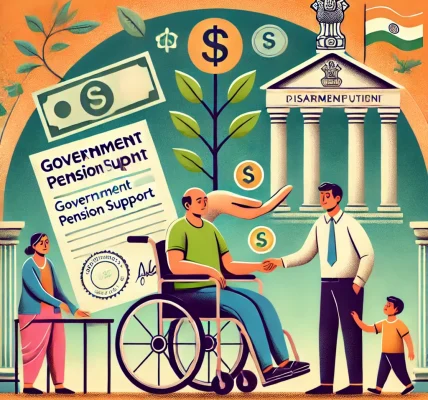Understanding the Role of Government Pension Schemes in India’s Social Security System
Introduction
Government pension schemes play a vital role in India’s social security system by providing financial stability to individuals post-retirement. These schemes aim to offer a secure and reliable income source to senior citizens, employees, and vulnerable sections of society. By ensuring financial independence, government-backed pensions contribute to the overall economic well-being of the country.
This article explores the importance of government pension schemes, their various types, benefits, eligibility, and their impact on India’s social security framework.
The Importance of Government Pension Schemes
A pension scheme is a financial instrument designed to provide individuals with income after retirement. In India, where a significant portion of the workforce is in the unorganized sector, government-backed pension schemes act as a critical safety net. These schemes help reduce poverty among senior citizens and lessen the financial burden on families.
Key Benefits:
- Financial Security – Ensures a stable income after retirement.
- Reduced Dependency – Helps retirees become financially independent.
- Tax Benefits – Some pension schemes offer tax exemptions under various sections of the Income Tax Act.
- Inflation Protection – Government pension schemes are periodically revised to counter inflation.
- Support for Vulnerable Groups – Special pension schemes exist for widows, disabled individuals, and economically weaker sections.
Types of Government Pension Schemes in India
The Government of India offers various pension schemes catering to different sections of society. Below are some of the key schemes:
1. National Pension System (NPS)
- Open to all Indian citizens.
- Flexible investment options with tax benefits.
- Pension amount depends on contributions and returns on investment.
2. Employees’ Pension Scheme (EPS)
- Available to employees working in establishments covered under the Employees’ Provident Fund (EPF) Act.
- Provides pension benefits to employees after the age of 58.
- Minimum service requirement of 10 years.
3. Atal Pension Yojana (APY)
- Aimed at workers in the unorganized sector.
- Offers a fixed pension of ₹1,000 to ₹5,000 per month depending on contributions.
- Government co-contribution for eligible subscribers.
4. Indira Gandhi National Old Age Pension Scheme (IGNOAPS)
- Provides financial assistance to senior citizens aged 60 and above from Below Poverty Line (BPL) families.
- Monthly pension of ₹200 for ages 60–79 and ₹500 for ages 80 and above.
5. Pradhan Mantri Shram Yogi Maan-dhan (PM-SYM)
- Designed for unorganized sector workers earning up to ₹15,000 per month.
- Assured monthly pension of ₹3,000 after the age of 60.
- Government matches the contribution made by the individual.
6. Widow Pension Scheme
- Provides financial aid to widows belonging to BPL families.
- Pension amount varies across different states.
7. Disability Pension Scheme
- Offers financial assistance to disabled individuals who cannot earn a livelihood.
- Pension amount and eligibility criteria differ by state.
How These Schemes Strengthen Social Security
Government pension schemes contribute significantly to India’s social security system by ensuring:
- Retirement Security: Enables senior citizens to maintain their standard of living without financial hardships.
- Poverty Alleviation: Reduces economic distress among elderly individuals, especially in rural areas.
- Encouragement for Savings: Incentivizes people to invest in pension schemes for long-term financial stability.
- Social Welfare: Provides financial aid to marginalized and vulnerable communities.
- Economic Stability: Ensures a steady flow of funds in the economy by providing financial security to a large population.
Eligibility Criteria for Government Pension Schemes
Each pension scheme has specific eligibility criteria based on age, income, and employment status. However, some common factors include:
- Age Requirement: Most schemes require individuals to be 18-60 years old at the time of enrollment.
- Income Category: Some schemes are exclusively for people from economically weaker sections or the unorganized sector.
- Employment Status: Certain pension plans are restricted to salaried employees or workers in specific industries.
- Contribution Requirement: Many pension schemes require regular contributions to be eligible for benefits post-retirement.
How to Apply for Government Pension Schemes
Applying for a government pension scheme is now easier with online and offline registration options. Here’s how individuals can enroll:
- Online Application:
- Visit the official government portal (e.g., NPS Trust, EPFO, or NSAP websites).
- Register using Aadhaar and PAN details.
- Select the preferred pension scheme and contribution amount.
- Complete e-KYC verification and submit the application.
- Offline Application:
- Visit the nearest bank, post office, or government office handling pension schemes.
- Fill out the application form and attach necessary documents.
- Submit the form along with the first installment of the contribution (if applicable).
- Collect the acknowledgment receipt and tracking ID.
Common Challenges and Government Initiatives
Despite their benefits, government pension schemes face some challenges:
- Lack of Awareness: Many eligible citizens are unaware of pension benefits and fail to enroll.
- Complex Procedures: Some schemes have complicated registration processes, discouraging participation.
- Delayed Payments: Pension disbursement delays can cause financial stress for beneficiaries.
To address these issues, the government has introduced:
- Digital Initiatives: Online portals and mobile apps for seamless pension registration and tracking.
- Awareness Campaigns: Educating citizens through TV, radio, and social media.
- Simplified Procedures: E-KYC and Aadhaar integration for hassle-free enrollment.
Conclusion
Government pension schemes form the backbone of India’s social security system, ensuring financial security for millions. These schemes not only safeguard the elderly but also provide stability to marginalized groups. As the government continues to enhance and expand pension programs, it is crucial for individuals to understand their options and plan for a secure retirement.
By enrolling in a suitable pension scheme, individuals can enjoy financial independence and peace of mind in their later years. With the growing emphasis on digital inclusion and financial literacy, the future of India’s pension system looks promising




